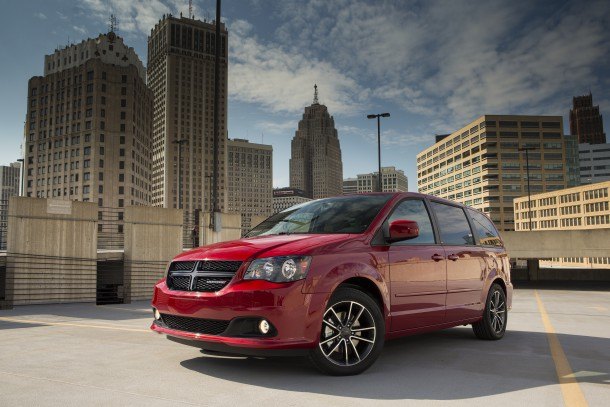Sergio Doesn't Know What to Do With the Dodge Grand Caravan

(Update: A previous version of this story stated that the Honda Odyssey was the top-selling minivan in the U.S. in 2016. The number one spot actually goes to the Toyota Sienna.)
After being granted a stay of execution, the Dodge Grand Caravan’s hazy, undefined lifespan remains a controversial topic in Auburn Hills.
The Moses of minivans continues to trundle off Fiat Chrysler Automobiles’ Windsor, Ontario assembly line, alongside its far-more-advanced Chrysler Pacifica stablemate. Compared to the tech-laden Pacifica, the venerable Grand Caravan offers an acceptable level of content at a lower price point, and its reprieve was in keeping with FCA’s tendency to keep money-making models around for extended periods of time. Together, the two models span the segment’s price range.
The unavoidable question for FCA is: how long can the Grand Caravan stay in the lineup?
“That is the point of heated debate on the inside of FCA,” said FCA CEO Sergio Marchionne during a media conference at the North American International Auto Show. “When we shut production of the Grand Caravan is not clear to us yet.”
In November, a letter sent from a parts supplier to Canadian autoworkers union Unifor stated that the end of the line for the aging model will come in July 2019. A crossover would replace the Grand Caravan, the letter said.
Marchionne claimed that rumors claiming FCA would begin phasing out the model this year are absolutely not true, before adding — maddeningly — “probably not.”
Rather than being handed a death notice in 2016, the Grand Caravan ended the year as the second-highest-selling minivan on the U.S. market, losing to the Toyota Sienna by a margin of only 113 units. With 127,678 units sold in the U.S. last year, the model topped its 2015 tally by over 25 percent. North of the border, the Grand Caravan remains enormously popular, with 51,513 units sold in 2016.
The biggest attraction to keeping the Grand Caravan around, besides its continued popularity, is the older model’s much lower entry price. While the Pacifica has enjoyed glowing praise, the all-new platform and high level of technology warrants a premium sticker price, potentially leaving childbearing millennials out in the cold. Only the base Pacifica retails for under $30,000, with upper trim lines pushing past the $40,000 mark. The Grand Caravan, however, stickers for $23,595, usually with a pile of manufacturer cash on the hood driving the price below $20,000.
For FCA, filling a gap with a very old product suits the company just fine.
When asked about the gulf between the two minivans, and the argument that Pacifica sales could be affected by the model’s price, Marchionne wasn’t condemning anyone or anything.
“We had the same story with the Grand Cherokee back in (2010),” said Marchionne. “It took us about 12 months to get geared up. It has received more awards than any minivan I’ve heard of. It’s a lot more expensive than the outgoing vehicle. We know that from a quality standpoint and what it offers the marketplace, there’s no better. Give us some time — I think we need to take out the imports and place the Pacifica at the top of the list.”
Marchionne did say the automaker needs to look at the Pacifica’s price range.
FCA needs “to offer some level of affordable access to the Pacifica at the low-end,” he said, adding that the same pricing issue arises with most new models.
“The Grand Caravan has got limitations — it’s very old architecture.”
[Image: Fiat Chrysler Automobiles]

More by Steph Willems
Latest Car Reviews
Read moreLatest Product Reviews
Read moreRecent Comments
- AZFelix I shall fully endorse the use of autonomous cars on public roads once they have successfully completed my proposed Turing test for self driving vehicles. This test requires the successful completion of an at fault incident and accident free 24/7 driving session in Buffalo and upstate New York from October 1st until March 31st, and throughout the city of Jakarta, Indonesia for one consecutive year. Only Level 1 and Level 5 vehicles are permissible.
- Lou_BC I'd go Rav4. No Mazda dealer in my town and from what I've seen, Mazda's tend to rust.
- Steve Jacobs I've got a bright Red Kia EV6. Easy to find in a parking lot.
- MKizzy Gently used EV6's under $30K aren't hard to find and have the range and style to almost intrigue me into taking the EV plunge. However, I'll wait for a mid-sized non-luxury EV sedan or wagon which is not a tablet housing a car (Model 3) or sacrifices too much usable space for the sake of style (Ioniq 6) before I go electric. I'm not holding my breath.
- Arthur Dailey Am currently comparing both vehicles. Some issues not addressed in the article 1) the wait times for most RAV4's are currently considerably longer, 2) RAV4's are among the most stolen vehicles in my area (the GTA), 3) Mazda has a superior warranty. Manufacturing locations are perhaps a toss up. For the majority of these vehicles sold in the Canadian market from what I can ascertain, CX-5's are manufactured in Japan, and RAV4's in Alliston Ontario. One area where I will disagree with Matt is in the upholstery. I far prefer cloth to leather. With grandchildren and a dog, there is far more chance that the leather will be cut or scratched. And leather, particularly in black is too hot in the summer and very cold when you first sit on it during a Canadian winter. Cloth is the winner in that competition, but still an inferior choice to rich 1970's style velour upholstery.


































Comments
Join the conversation
I always thought the GC could use an SRT6 version.
Sergio is the Roger Smith of this era. It is not going to end well for him. I almost feel sorry for this egomaniac.